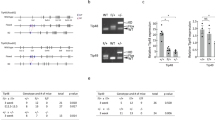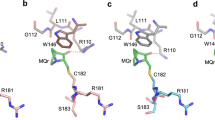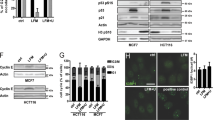Abstract
We have previously identified PRIMA-1, a low molecular weight compound that restores the transcriptional transactivation function to mutant p53 and induction of apoptosis. To explore the molecular mechanism for PRIMA-1-induced mutant p53-dependent apoptosis, we examined the intracellular distribution of mutant p53 upon treatment with PRIMA-1MET by immunofluorescence staining. We found that PRIMA-1MET induced nucleolar translocation of mutant p53 and the promyelocytic leukemia (PML) nuclear body-associated proteins PML, CBP and Hsp70. Levels of Hsp70 were significantly enhanced by PRIMA-1MET treatment. PRIMA-Dead, a compound structurally related to PRIMA-1 but unable to induce mutant p53-dependent apoptosis, failed to induce nucleolar translocation of mutant p53. Our results suggest that redistribution of mutant p53 to nucleoli plays a role in PRIMA-1-induced apoptosis.
This is a preview of subscription content, access via your institution
Access options
Subscribe to this journal
Receive 50 print issues and online access
$259.00 per year
only $5.18 per issue
Buy this article
- Purchase on Springer Link
- Instant access to full article PDF
Prices may be subject to local taxes which are calculated during checkout






Similar content being viewed by others
References
Amin HM, Saeed S, Alkan S . (2001). Histone deacetylase inhibitors induce caspase-dependent apoptosis and downregulation of daxx in acute promyelocytic leukaemia with t(15;17). Br J Haematol 115: 287–297.
Arabi A, Rustum C, Hallberg E, Wright AP . (2003). Accumulation of c-Myc and proteasomes at the nucleoli of cells containing elevated c-Myc protein levels. J Cell Sci 116: 1707–1717.
Arabi A, Wu S, Ridderstrale K, Bierhoff H, Shiue C, Fatyol K et al. (2005). c-Myc associates with ribosomal DNA and activates RNA polymerase I transcription. Nat Cell Biol 7: 303–310.
Bernardi R, Scaglioni PP, Bergmann S, Horn HF, Vousden KH, Pandolfi PP . (2004). PML regulates p53 stability by sequestering Mdm2 to the nucleolus. Nat Cell Biol 6: 665–672.
Bischof O, Kim SH, Irving J, Beresten S, Ellis NA, Campisi J . (2001). Regulation and localization of the Bloom syndrome protein in response to DNA damage. J Cell Biol 153: 367–380.
Bischof O, Kirsh O, Pearson M, Itahana K, Pelicci PG, Dejean A . (2002). Deconstructing PML-induced premature senescence. EMBO J 21: 3358–3369.
Bykov JV, Issaeva N, Selivanova G, Wiman KG . (2002a). Mutant p53-dependent growth suppression distinguishes PRIMA-1 from known anticancer drugs: a statistical analysis of information in the National Cancer Institute database. Carcinogenesis 23: 2011–2018.
Bykov JV, Issaeva N, Shilov A, Hultcrantz M, Pugacheva E, Chumakov P et al. (2002b). Restoration of the tumor suppressor function to mutant p53 by a low-molecular-weight compound. Nat Med 8: 282–288.
Bykov VJ, Issaeva N, Zache N, Shilov A, Hultcrantz M, Bergman J et al. (2005a). Reactivation of mutant p53 and induction of apoptosis in human tumor cells by maleimide analogs. J Biol Chem 280: 30384–30391.
Bykov VJ, Zache N, Stridh H, Westman J, Bergman J, Selivanova G et al. (2005b). PRIMA-1(MET) synergizes with cisplatin to induce tumor cell apoptosis. Oncogene 24: 3484–3491.
Cairns CA, White RJ . (1998). p53 is a general repressor of RNA polymerase III transcription. EMBO J 17: 3112–3123.
Carbone R, Pearson M, Minucci S, Pelicci PG . (2002). PML NBs associate with the hMre11 complex and p53 at sites of irradiation induced DNA damage. Oncogene 21: 1633–1640.
Cohen N, Sharma M, Kentsis A, Perez JM, Strudwick S, Borden KL . (2001). PML RING suppresses oncogenic transformation by reducing the affinity of eIF4E for mRNA. EMBO J 20: 4547–4559.
D'Orazi G, Cecchinelli B, Bruno T, Manni I, Higashimoto Y, Saito S et al. (2002). Homeodomain-interacting protein kinase-2 phosphorylates p53 at Ser 46 and mediates apoptosis. Nat Cell Biol 4: 11–19.
Drouin A, Schmitt A, Masse JM, Cieutat AM, Fichelson S, Cramer EM . (2001). Identification of PML oncogenic domains (PODs) in human megakaryocytes. Exp Cell Res 271: 277–285.
Everett RD . (2001). DNA viruses and viral proteins that interact with PML nuclear bodies. Oncogene 20: 7266–7273.
Everett RD, Meredith M, Orr A, Cross A, Kathoria M, Parkinson J . (1997). A novel ubiquitin-specific protease is dynamically associated with the PML nuclear domain and binds to a herpesvirus regulatory protein. EMBO J 16: 1519–1530.
Fagioli M, Alcalay M, Tomassoni L, Ferrucci PF, Mencarelli A, Riganelli D et al. (1998). Cooperation between the RING+B1–B2 and coiled-coil domains of PML is necessary for its effects on cell survival. Oncogene 16: 2905–2913.
Ferbeyre G, de Stanchina E, Querido E, Baptiste N, Prives C, Lowe SW . (2000). PML is induced by oncogenic ras and promotes premature senescence. Genes Dev 14: 2015–2027.
Fogal V, Gostissa M, Sandy P, Zacchi P, Sternsdorf T, Jensen K et al. (2000). Regulation of p53 activity in nuclear bodies by a specific PML isoform. EMBO J 19: 6185–6195.
Foster BA, Coffey HA, Morin MJ, Rastinejad F . (1999). Pharmacological rescue of mutant p53 conformation and function. Science 286: 2507–2510.
Guo A, Salomoni P, Luo J, Shih A, Zhong S, Gu W et al. (2000). The function of PML in p53-dependent apoptosis. Nat Cell Biol 2: 730–736.
Hofmann TG, Moller A, Sirma H, Zentgraf H, Taya Y, Droge W et al. (2002). Regulation of p53 activity by its interaction with homeodomain-interacting protein kinase-2. Nat Cell Biol 4: 1–10.
Lallemand-Breitenbach V, Zhu J, Puvion F, Koken M, Honore N, Doubeikovsky A et al. (2001). Role of promyelocytic leukemia (PML) sumolation in nuclear body formation, 11S proteasome recruitment, and As2O3-induced PML or PML/retinoic acid receptor alpha degradation. J Exp Med 193: 1361–1371.
Langley E, Pearson M, Faretta M, Bauer UM, Frye RA, Minucci S et al. (2002). Human SIR2 deacetylates p53 and antagonizes PML/p53-induced cellular senescence. EMBO J 21: 2383–2396.
Le XF, Yang P, Chang KS . (1996). Analysis of the growth and transformation suppressor domains of promyelocytic leukemia gene, PML. J Biol Chem 271: 130–135.
Li H, Leo C, Zhu J, Wu X, O'Neil J, Park EJ et al. (2000). Sequestration and inhibition of Daxx-mediated transcriptional repression by PML. Mol Cell Biol 20: 1784–1796.
Li M, Chen D, Shiloh A, Luo J, Nikolaev AY, Qin J et al. (2002). Deubiquitination of p53 by HAUSP is an important pathway for p53 stabilization. Nature 416: 648–653.
Louria-Hayon I, Grossman T, Sionov RV, Alsheich O, Pandolfi PP, Haupt Y . (2003). The promyelocytic leukemia protein protects p53 from Mdm2-mediated inhibition and degradation. J Biol Chem 278: 33134–33141.
Mattsson K, Pokrovskaja K, Kiss C, Klein G, Szekely L . (2001). Proteins associated with the promyelocytic leukemia gene product (PML)-containing nuclear body move to the nucleolus upon inhibition of proteasome-dependent protein degradation. Proc Natl Acad Sci USA 98: 1012–1017.
Melnick A, Licht JD . (1999). Deconstructing a disease: RARalpha, its fusion partners, and their roles in the pathogenesis of acute promyelocytic leukemia. Blood 93: 3167–3215.
Olivier M, Eeles R, Hollstein M, Khan MA, Harris CC, Hainaut P . (2002). The IARC TP53 database: new online mutation analysis and recommendations to users. Hum Mutat 19: 607–614.
Olson MO, Dundr M . (2005). The moving parts of the nucleolus. Histochem Cell Biol 123: 203–216.
Pearson M, Carbone R, Sebastiani C, Cioce M, Fagioli M, Saito S et al. (2000). PML regulates p53 acetylation and premature senescence induced by oncogenic Ras. Nature 406: 207–210.
Pespeni M, Hodnett M, Pittet JF . (2005). In vivo stress preconditioning. Methods 35: 158–164.
Pokrovskaja K, Mattsson K, Kashuba E, Klein G, Szekely L . (2001). Proteasome inhibitor induces nucleolar translocation of Epstein-Barr virus-encoded EBNA-5. J Gen Virol 82: 345–358.
Regad T, Chelbi-Alix MK . (2001). Role and fate of PML nuclear bodies in response to interferon and viral infections. Oncogene 20: 7274–7286.
Rehman A, Chahal MS, Tang X, Bruce JE, Pommier Y, Daoud SS . (2005). Proteomic identification of heat shock protein 90 as a candidate target for p53 mutation reactivation by PRIMA-1 in breast cancer cells. Breast Cancer Res 7: R765–R774.
Rubbi CP, Milner J . (2003). Disruption of the nucleolus mediates stabilization of p53 in response to DNA damage and other stresses. EMBO J 22: 6068–6077.
Ruggero D, Pandolfi PP . (2003). Does the ribosome translate cancer? Nat Rev Cancer 3: 179–192.
Salomoni P, Pandolfi PP . (2002). The role of PML in tumor suppression. Cell 108: 165–170.
Tao W, Levine AJ . (1999). P19(ARF) stabilizes p53 by blocking nucleo-cytoplasmic shuttling of Mdm2. Proc Natl Acad Sci USA 96: 6937–6941.
Visintin R, Hwang ES, Amon A . (1999). Cfi1 prevents premature exit from mitosis by anchoring Cdc14 phosphatase in the nucleolus. Nature 398: 818–823.
Vousden KH, Lu X . (2002). Live or let die: the cell's response to p53. Nat Rev Cancer 2: 594–604.
Wang ZG, Ruggero D, Ronchetti S, Zhong S, Gaboli M, Rivi R et al. (1998). PML is essential for multiple apoptotic pathways. Nat Genet 20: 266–272.
Yang S, Kuo C, Bisi JE, Kim MK . (2002). PML-dependent apoptosis after DNA damage is regulated by the checkpoint kinase hCds1/Chk2. Nat Cell Biol 4: 865–870.
Zhai W, Comai L . (2000). Repression of RNA polymerase I transcription by the tumor suppressor p53. Mol Cell Biol 20: 5930–5938.
Zhong S, Salomoni P, Pandolfi PP . (2000). The transcriptional role of PML and the nuclear body. Nat Cell Biol 2: E85–E90.
Acknowledgements
This work was supported by grants from Cancerfonden, the Karolinska Institute, the Ingabritt & Arne Lundberg Foundation, and the 6th EU framework program. The information in this document is provided as is and no guarantee or warranty is given that the information is fit for any particular purpose. The user thereof uses the information at its sole risk and liability. The community is not liable for any use that may be made of the information contained herein.
Author information
Authors and Affiliations
Corresponding author
Rights and permissions
About this article
Cite this article
Rökaeus, N., Klein, G., Wiman, K. et al. PRIMA-1MET induces nucleolar accumulation of mutant p53 and PML nuclear body-associated proteins. Oncogene 26, 982–992 (2007). https://doi.org/10.1038/sj.onc.1209858
Received:
Revised:
Accepted:
Published:
Issue Date:
DOI: https://doi.org/10.1038/sj.onc.1209858
Keywords
This article is cited by
-
PRIMA-1MET/APR-246 targets mutant forms of p53 family members p63 and p73
Oncogene (2010)
-
Mutant p53 reactivation by PRIMA-1MET induces multiple signaling pathways converging on apoptosis
Oncogene (2010)
-
PRIMA-1MET induces nucleolar translocation of Epstein-Barr virus-encoded EBNA-5 protein
Molecular Cancer (2009)
-
Energy-dependent nucleolar localization of p53 in vitro requires two discrete regions within the p53 carboxyl terminus
Oncogene (2007)
-
Reactivation of mutant p53: molecular mechanisms and therapeutic potential
Oncogene (2007)



